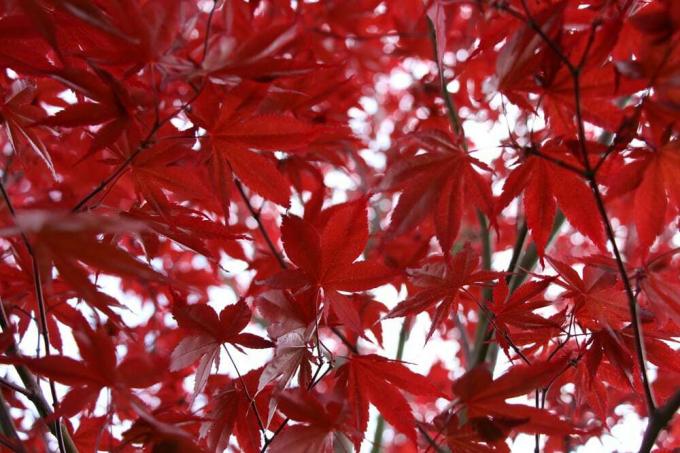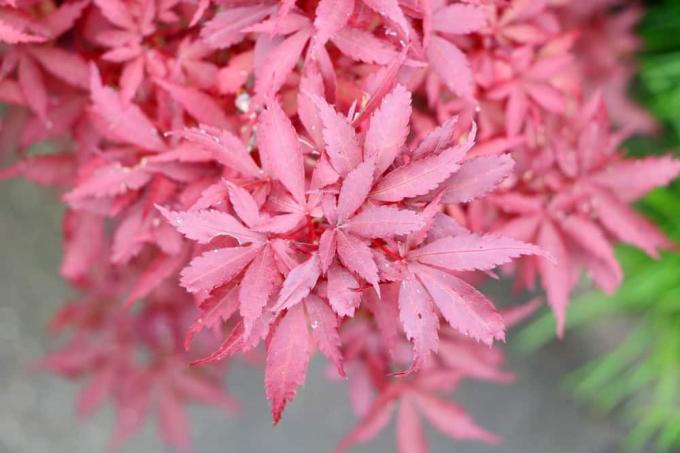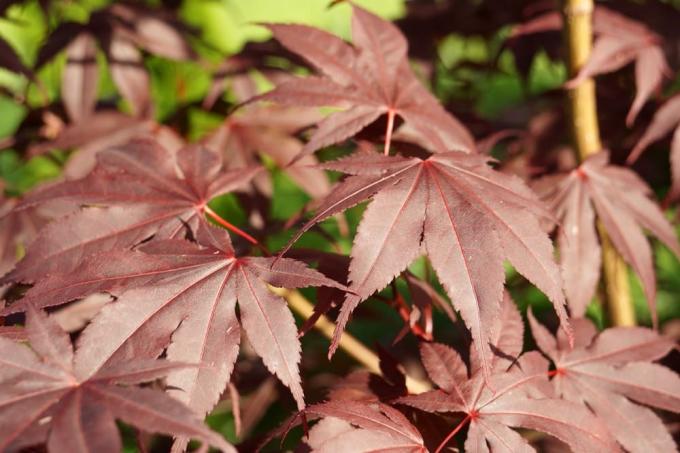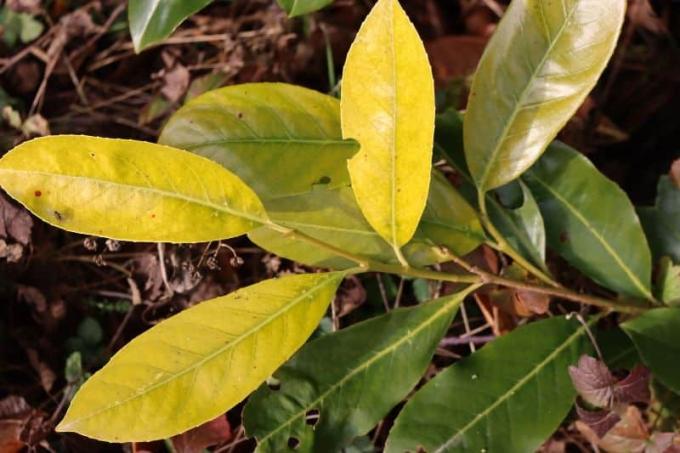

Table of contents
- location and soil quality
- planting time
- Plant
- Pour
- Fertilize
- Cut
- hibernate
- transplant
- Diseases
- tar spot disease
- red pustular disease
- mildew
With the native Norway maple as its progenitor, Red Maple can rely on its home advantage with reliable winter hardiness. In order for the spectacular head graft to develop into an impressive house tree, important aspects of cultivation are important. Location, soil quality, cutting care, water and nutrient supply make an important contribution to healthy, shapely growth. These instructions deepen the basics of care with practical tips and useful hints. This is how red-leaved spherical maple develops into a magnificent specimen.
location and soil quality
Roter Kugelahorn already proves its home advantage when choosing a location. The picturesque deciduous tree has proven to be heat and urban climate tolerant, paired with a pronounced tolerance to light and temperature conditions. In order for the representative Acer platanoides 'Crimson Sentry' to show itself from its most beautiful side, the following general conditions offer ideal conditions:
- Sunny to semi-shady location
- Ideally in the slipstream, but not a mandatory premise
- Normal, nutritious bedding soil, preferably loamy-sandy and calcareous
- Loose soil structure, permeable and without the risk of waterlogging
The list of undesirable site conditions is significantly shorter. In acidic, wet, boggy soil on the cold, light-poor north side, red-leaved maple loses its will to live and does not live up to its good reputation as a magnificent specimen.
Tip:
Home gardeners with families have been concerned about maples since sycamore seeds have been suspected to be the cause of sudden grazing deaths in horses. A Dutch research team has carefully examined whether other maple species also contain toxic substances and given the all-clear. Norway maple and its magnificent globe maple cultivars 'Globosum' and 'Crimson Sentry' are non-toxic and perfect as a house tree for the family garden.
planting time

Best planting time for maple 'Crimson Sentry' is in autumn. In the sun-warmed soil of September and October, your new house tree will find ideal conditions for a healthy and vital start to floral life. If you bought a young tree in spring or summer as a container plant, there is nothing wrong with planting it immediately. The planting date should only be postponed in the case of bitter frost or summer drought.
Plant
With careful soil preparation, you set the course for a flawless planting process. Dig a pit that is twice the volume of the bale. Please enrich one third of the excavation with mature compost and a few handfuls of horn shavings. To curb the urge to spread from the predominantly shallow root system, dress the Plant pit out with a root barrier that is about 30 inches deep and 5 to 10 inches above the soil edge suffices. Your new tree will spend the waiting time in a bucket of water. As long as air bubbles rise, the root ball can soak itself with water. The seed pot is only removed shortly before planting. The workflow continues like this:
- Drive a support stake into the planting hole that reaches halfway up the crown
- Position the stuffed bale in the middle of the pit
- Important: the ball surface is a maximum of 5 cm below the bed surface
- Form a pouring rim by hand for optimal watering
Fill the pit with the enriched substrate in stages. To prevent cavities from forming, tread down the earth in the meantime without massively compacting it. Generous watering marks the end of the planting work. A 5 cm layer of bark mulch, compost or autumn leaves is recommended. Finally, connect the support post and trunk with wide binding material to protect the freshly planted maple from wind.
Pour
In the first few weeks after planting, adequate water supply is a key part of care. If rain clouds don't provide enough moisture, please water regularly and plentifully. Let the water run onto the root disc until the first puddles indicate that the soil is saturated. Waterlogging is just as detrimental to growth as drought stress. If red maple has rooted well in the ground, the water requirement is reduced to watering Drought because the heart root's deep and far-reaching root system down to the stores in the soil has advanced.
Fertilize
Provide your red-leaved Acer platanoides with organic fertilizer once a year. Equipped with a balanced nutrient balance, the deciduous tree is well prepared for winter hardships and can rely on robust defenses when pathogens attack should. How to properly fertilize your red 'Crimson Sentry':
- The best time is in early autumn during the months of August and September
- Distribute 3 liters of mature compost per square meter of tree disc
- Carefully work in the fertilizer with the rake without causing damage to the roots
- Shower with potassium-rich plant manure made from comfrey leaves
The combination of a natural nutrient buffet and potassium is just what your house tree needs in autumn. By spring, hard-working soil organisms have processed the compost to such an extent that its ingredients are available to the tree. Just in time for the new season, all energy reserves are available for the red maple so that it can put on its colorful foliage again. The main nutrient potassium is already active in winter to strengthen the cell tissue and lower the freezing point in the plant sap.
Tip:
Home gardeners without their own compost heap fall back on packaged goods from the garden center. Patent potash or potash magnesia serves as a substitute for comfrey manure.
Cut
Red-leaved 'Crimson Sentry' does not form a spherical crown by itself, like its green-leaved counterpart Acer platanoides 'Globosum'. Red maple naturally tends to have an oval to ovoid crown shape. You can give free rein to this pursuit and enjoy the silhouette. As a second option, direct the growth in the desired direction with planned pruning measures. The decisive criterion for the ideal point in time is the sap flow. In early autumn, the high sap pressure characteristic of all maple species decreases for a short time, so that the tree bleeds little after pruning. This is how you cut red-leaved maple in an exemplary manner:
- The best time is late September to late October
- Sharpen pruning shears and disinfect with alcohol
- Pruning out damaged, dead and inward branches
- Cut back shoots protruding from the mold in the thumb-thick area
- Select cutting point at short distance (3-5 mm) to buds that point outwards

Don't you see any reason to intervene in the natural crown formation? Then the pruning care is reduced to occasional thinning out of dead wood. For this purpose, every two to three years in autumn, remove those shoots that no longer contribute to the well-groomed appearance. Use a handy folding saw to cut off the relevant branches in front of the branch ring. You can recognize the knot ring as a bulging thickening in the transition from the knot to the trunk.
Tip:
A test cut provides information about the ideal time to cut the red-leaved maple. Cut off a piece of two thin, finger-thick shoots and watch the juice flow. If only a little sap emerges, the tree gives the go-ahead for pruning. Massive bleeding signals that the timing should be pushed back a week or two.
hibernate
The topic of winter protection is primarily important in the first two years of standing. By then, an adult red maple will have established itself at the site to the point where it can stand up to the freezing cold on its own. How to properly winter your red-leaved 'Crimson Sentry':
- Stack leaves on the tree grate before the onset of winter
- Fix with pins
- Alternatively, pile up compost or bark mulch
The young stem bark is prone to cracking. When blazing sunshine hits the bark at temperatures below freezing, the tissue cannot withstand the load and tears. You can prevent this dilemma by wrapping the trunk with jute ribbons or garden fleece. Likewise, erected wooden slats or reed mats are sufficient to protect the sensitive stem tissue from a winter tear.
transplant
Due to given occasions, it may be necessary to extend the normal care program to include a change of location. At least in the first five years, a red maple will forgive you if it has to leave its usual place. To successfully transplant the deciduous tree, follow these steps:
- The best time is after the leaves have fallen in autumn
- Thin out some of the thickest, oldest branches on Astring
- Cut back the crown by a maximum of one third
- Cut off the root disk in the large radius (3/4 of the growth height).
- Widen the cut area into a 10 cm wide furrow
- Cut off any remaining roots from this furrow and loosen the ball
With your combined strength, you lift the red maple tree out of the ground. Immediately wrap the root ball in a jute sack to take the valuable soil with you to the new location. The recommended pruning before relocation has two important functions. The weight of the tree is significantly reduced, which noticeably reduces the effort required for you and your helpers. Furthermore, you compensate for the lost root mass again in this way.
Diseases
If home gardeners heed the basics of care, red maple rarely becomes the target of pathogens. However, red-leaved 'Crimson Sentry' is not completely immune to plant diseases. The focus is on three infections that can cause problems for the elegant deciduous tree. Find out here about typical symptoms and tried-and-tested tips for combating them:
tar spot disease

It starts at the beginning of summer. Yellow spots spread out on the dark red ornamental leaves. As the bright yellow fall color develops, the spots turn black in color, which is what the name of the fungal infection refers to. Instead of competing with the golden October sun, the leaves fall off prematurely. The good news is that you don't have to resort to chemical fungicides to control tar spot disease. It is necessary to interrupt the fatal development cycle. To do this, remove all foliage to burn or dispose of with household waste.
red pustular disease
One of the most common diseases on the red-leaved maple acts as a weakness parasite. The symptoms cannot be ignored. Vermilion pustules spread across the tree bark and shoots. If left unchecked, it will turn into cancerous growths. How to fight the dreaded red pustule disease:
- In September, cut back the entire crown down to the healthy wood
- Cut direction: 15-20 cm below the infestation and 3-5 mm above a leaf or eye
- Thoroughly clean and disinfect the cutting tool before and after
The pathogens of the red pustule disease primarily target the maple tree, which has been weakened by care errors. Put all framework conditions to the test in order to find and eliminate weak points.
mildew
The large lobed leaves magically attract powdery mildew spores. Infestation is recognizable by the mealy-white fungal growth on the upper sides of the leaves and yellowish pustules on the undersides of the leaves. There's a powerful remedy in your fridge. Fresh milk contains lecithin and microorganisms that make short work of fungal spores.
Tip:
Mix 1 liter of decalcified water with 1/8 liter of fresh milk (no UHT milk). Before you spray the milk water, cut off affected parts of the plant. Spray the crown dripping wet with the home remedy at intervals of 3 to 4 days.
 garden editorial
garden editorial I write about everything that interests me in my garden.
Learn more about shrubs

Cherry laurel has yellow / brown leaves: what to do?
Cherry laurel is one of the hardy garden plants in the garden. Nevertheless, it can happen that the leaves of the cherry laurel turn yellow or brown. The causes are manifold. Since some can kill the cherry laurel, you should investigate.

12 native evergreen shrubs & woody plants
Dreary, bare trees and bushes in winter? It doesn't have to be. Even in the European climatic conditions, native, evergreen trees thrive splendidly. The variety of species even enables the gardener to adapt his privacy hedge exactly to his garden design. This guide presents the most beautiful native and evergreen shrubs and woody plants.

Curb Vinegar | Does bucket or root barrier help?
Vinegar trees like to spread in the garden and sometimes even drive other plants away. However, this can be avoided by curbing the growth of the trees. You can find out which methods are best suited for this here!

Rhododendron has dried up: how to save it | Rododendron
Even if the rhododendron is withered and no longer sprout, it does not have to be dead. The plant can look completely dried up above ground, but there is often still life in the roots. It is therefore worth taking appropriate measures to save the flowering shrub.

Winter jasmine, Jasminum nudiflorum | Care, propagation & pruning
The winter jasmine is a relatively frugal and robust plant that can cope with many different site conditions. The plant enchants with bright yellow flowers in winter and tolerates deep sub-zero temperatures very well. It should be pruned regularly and is easy to propagate.

Ball Tree: Care from A – Z | These 9 varieties are suitable for ball trees
Ball trees adorn many a garden, front yard and entrance area. They require little space. Their trunk thickens with age, but its height remains the same. The spherical crown is easy to trim. Nevertheless, they offer everything that makes a tree.



